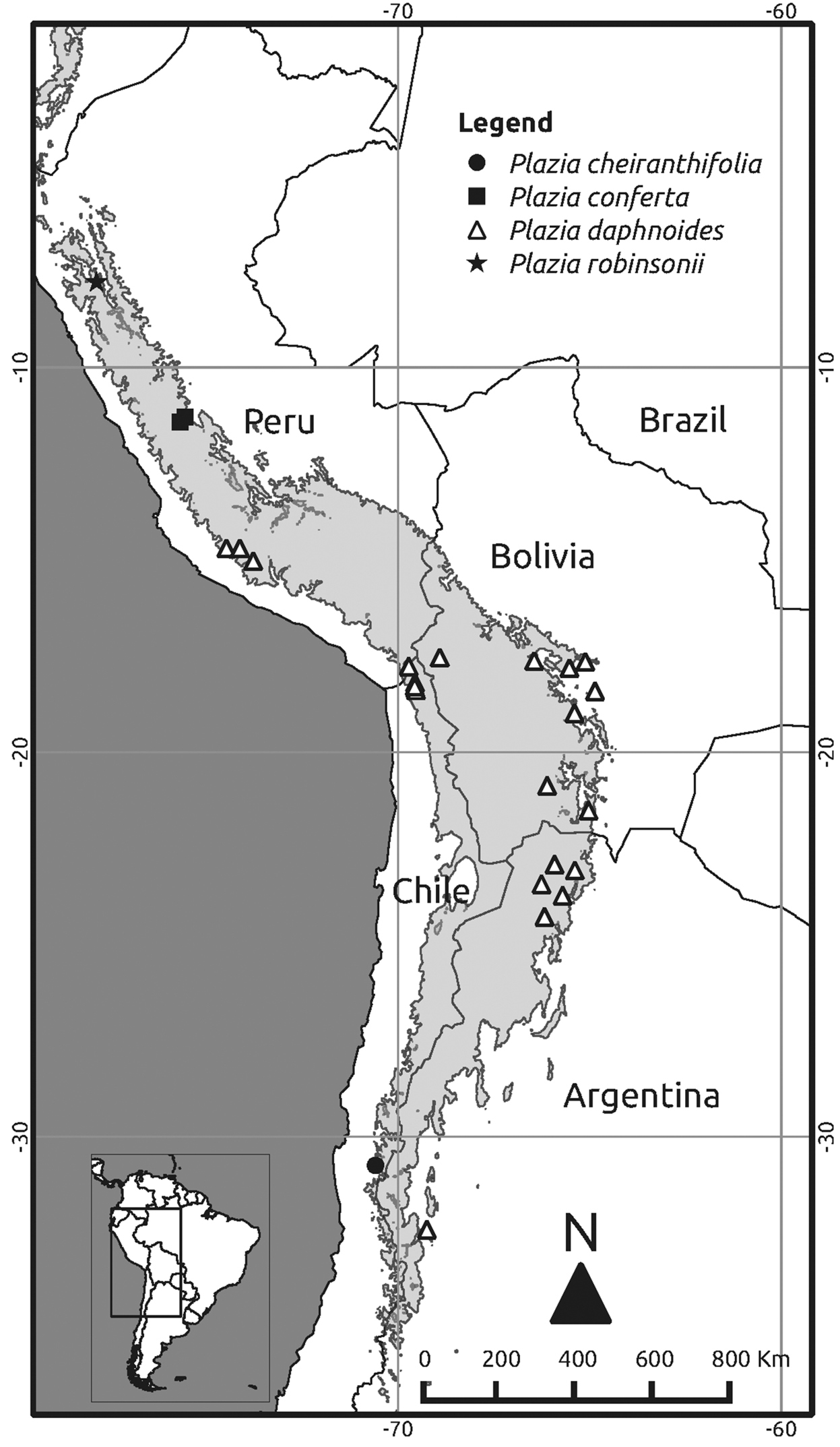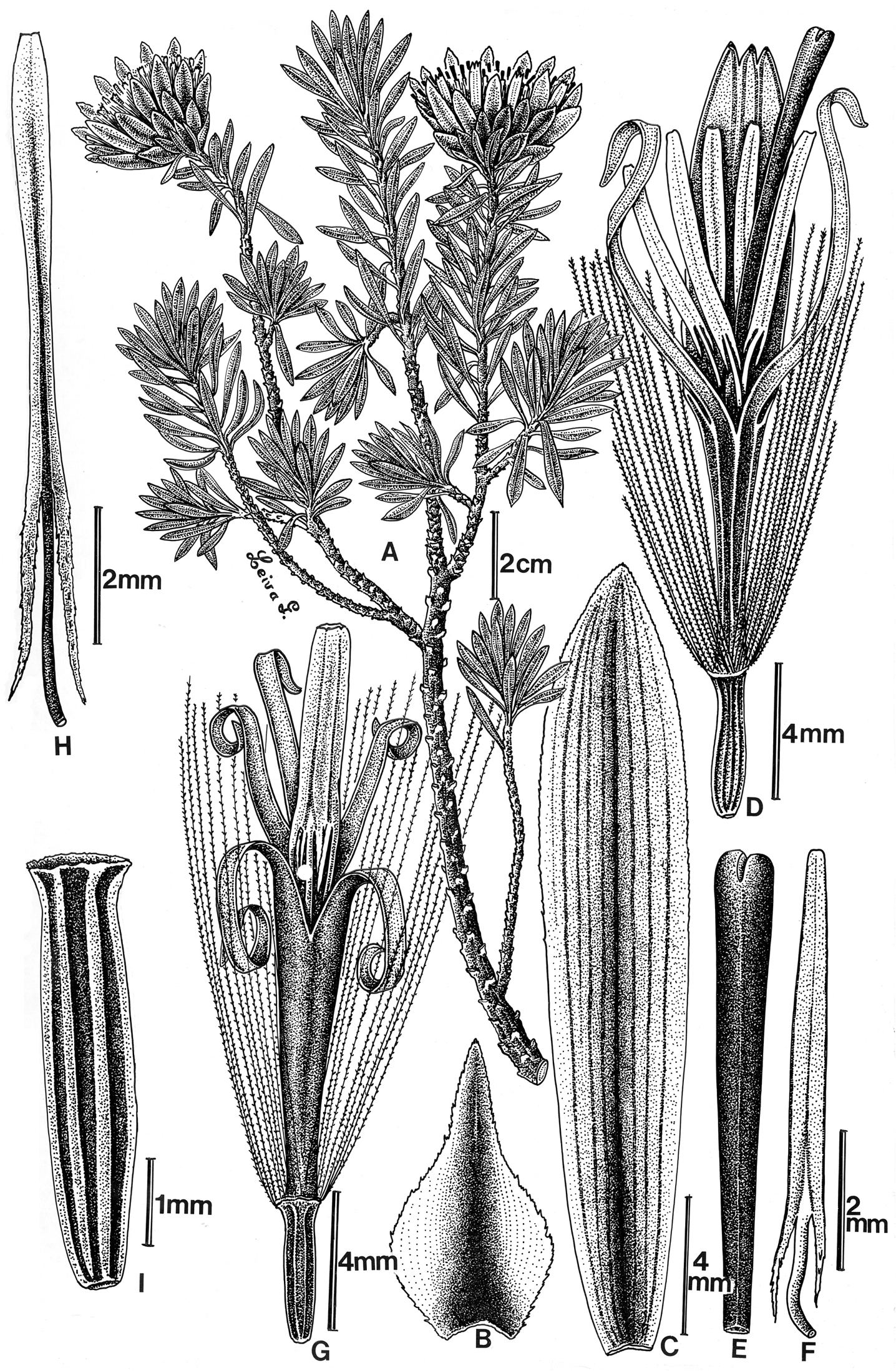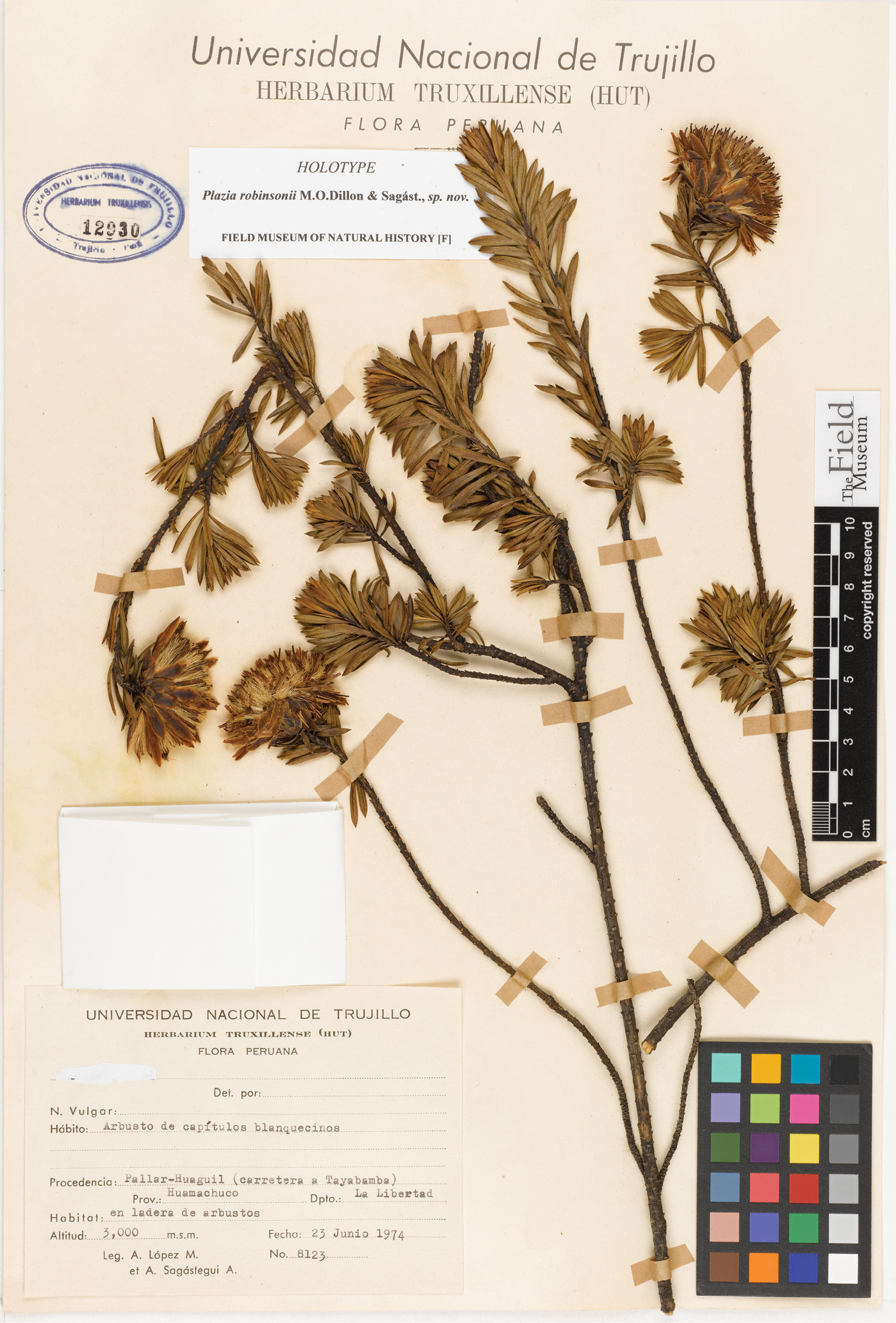






(C) 2014 Michael O. Dillon. This is an open access article distributed under the terms of the Creative Commons Attribution License (CC BY 4.0), which permits unrestricted use, distribution, and reproduction in any medium, provided the original author and source are credited.
For reference, use of the paginated PDF or printed version of this article is recommended.
Citation: Dillon MO, Luebert F (2014) Synopsis of Plazia Ruiz & Pav. (Onoserideae, Asteraceae), including a new species from northern Peru. PhytoKeys 34: 1–13. doi: 10.3897/phytokeys.34.6151
A synopsis of Plazia Ruiz & Pav. (Onoserideae, Asteraceae) is presented, including the description of a new species, Plazia robinsonii M.O.Dillon & Sagást., from a locality c. 20 kms west of Huamachuco, Department of La Libertad in northern Peru. It most closely resembles Plazia conferta Ruiz & Pav., a narrow endemic from central Peru some 450 km to the south; however, the latter species has larger leaves and smaller capitula. Plazia is a small genus of four species confined to the Andean Cordillera of Peru, Bolivia, Chile, and Argentina. A distribution map of the four species, an illustration of the new species, a photograph of the holotype, and a key to species are provided.
Se presenta una sinopsis del género Plazia Ruiz & Pav. (Onoserideae, Asteraceae), incluyendo la descripción de una nueva specie, Plazia robinsonii M.O.Dillon & Sagást., proveniente de una localidad c. 20 km al oeste de Huamachuco, Departamento de La Libertad, norte de Perú. Esta especie es similar a Plazia conferta Ruiz & Pav., un endemismo del centro de Perú, unos 450 km hacia el sur; sin emabrgo, esta última especie tiene hojas más grandes y capítulos más pequeños. Plazia es un género compuesto por cuatro especies restringidas a la Cordillera de los Andes de Perú, Bolivia, Chile y Argentina. Se inlcuye un mapa de distribución de las cuatro especies, una ilustración de la nueva especie, una fotografía del holotipo y una clave para las especies.
Asteraceae, Mutisioideae, Onoserideae, Plazia, endemics, new species, flora of Peru, Department of La Libertad
Plazia Ruiz & Pav. (Mutisioideae, Asteraceae) is a distinctive genus confined to the Andean Cordillera of Peru, Bolivia, Chile, and Argentina. It is easily recognized by its suffrutescent and decidedly woody habit with stems to a meter or more. The sessile leaves are tightly clustered and confined to the terminal 10–20 cm portions of the branch apices, the radiate capitula have ray florets with whitish to pink corollas and dark purple anthers long-exerted from the disc whitish florets.
Phylogenetic studies have shown that the genus Plazia belongs to the tribe Onoserideae, along with the genera Aphyllocladus Wedd., Gypothamnium Phil., Lycoseris Cass., Onoseris Willd., and Urmenetea Phil. (
The distribution of these genera involves the Atacama Desert, the high Andes of central and northern Chile, southern Peru, northwestern Argentina and western Bolivia, the Chaco and Monte Regions, as well as the inter-Andean valleys of central and northern Peru (
Distribution map of the currently recognized species of Plazia. The shaded area indicates high-elevation areas of the Andes above 3000 m. Locality data were obtained from
http://species-id.net/wiki/Plazia
Plazia conferta Ruiz & Pav.
Shrubs 1–2 m tall, the branches erect to ascending; stems lacking spines. Leaves simple, sessile, in whorls at branch tips; blades lanceolate to oblanceolate, glabrous to glandular, usually appressed, the margins entire. Capitulescences of solitary, terminal heads, sessile. Capitula heterogamous, radiate or more rarely homogamous, discoid; involucres cylindrical to campanulate; receptacles plane, glabrous; phyllaries 5–7-seriate, lanceolate; ray florets 5–25, the corollas ligulate-bilabiate, the outer lip 4-nerved, tridentate, the inner lip bifid; styles cylindric, glabrous, bifid, the branches short, inconspicuous; disc florets 7–40, the corollas tubular, actinomorphic, glabrous, the limb deeply 5-lobed, the lobes greater than 1/3 the length of the corolla, coiled; anthers linear, the terminal appendages lanceolate, fused into a column, truncate, the bases caudate; styles claviform, the branches short, rounded. Achenes glabrous or glandular-pubescent; pappus of scabrid bristles, isomorphic, yellowish. Chromosome number: unknown.
All species are confined to the Andean Cordillera and associated inter-Andean valleys (Fig. 1). Two species are confinded to Peru; both are rare and only known from a few collection localities. Another species is restricted to the Andes of central Chile. Plazia daphanoides Wedd. is the only wideranging species, being recorded from southern Peru and adjacent Argentina, Bolivia and Chile, usually in high-elevation, dry sites (
The genus Plazia was described by
| 1 | Leaves oblong or oblong-spathulate, 8–18 mm long, 2–3.5 mm wide; capitula with 5–8(–10) ray florets, (7–)10–11(–12) disc florets; involucres cylindrical (Argentina, Bolivia, Chile, Peru) | Plazia daphnoides Wedd. |
| – | Leaves elliptic to oblanceolate or oblong, 22–42 mm long, 3–6 mm wide; capitula lacking obvious ray florets or more commonly with 15–25 ray florets, (9–)20–25(–40) disc florets; involucres campanulate 2 | |
| 2 | Leaves oblong, 28–30 mm long, 7.5–8 mm; corollas more or less isomorphic, obvious ligules lacking (Central Chile) | Plazia cheiranthifolia (J.Rémy) Wedd. |
| – | Leaves oblanceolate, 10–25 mm long, 1–3 mm wide; corollas dimorphic, outer florets with ligules obvious (Peru) | 3 |
| 3 | Involucre 25–30 mm in diameter; ray florets 15–20, disc florets c. 40 | Plazia robinsonii M.O.Dillon & Sagást. |
| – | Involucre 12–16 mm in diameter; ray florets18–20, disc florets 10–20 | Plazia conferta Ruiz & Pav. |
http://species-id.net/wiki/Plazia_cheiranthifolia
CHILE, Región IV, Coquimbo, C. Gay s.n. (holotype: P00703596!; isotype: P00703598!).
Shrubs to 1.5 m tall; stems very resinous. Leaves oblong, 28–30 mm long, 7.5–8 mm wide, sessile, apically acute, 3–5-nerved, entire, thickened, glabrous. Capitulescences of solitary terminal heads. Capitula solitary, sessile; involucres campanulate, 25–30 mm long, c. 25 mm wide; phyllaries 3–4-seriate; inner lanceolate, 25–28 mm long, c. 3 mm wide; florets numerous, isomorphic, the outer with corollas subligulate. c. 10, lobes strongly coilled, inner florets 20–25; all corollas lobes c. 7 mm long, c. 4 mm wide, the tube c. 13 mm long; pappus to 16 mm long. Achenes 6–7-ribbed, glabrous, linear oblong, c. 7.5 mm long, c. 1.2 mm wide.
While it was once considered extinct, this species was recently rediscovered in the Precordillera of Ovalle (
Plazia cheiranthifolia is a rare shruby species apparently confined to the central Chilean region near Coquimbo. It has the longest leaves of any species of Plazia and large capitula with broadly campanulate involucres. Rémy described as his Aglaodendron chieranthifolium as homogamous, all with bilabiate corollas with lobes of varying lengths. From the photo in
Aglaeodendron cheiranthifolium J.Rémy was based upon a collection by Claudo Gay deposited in Paris (P00703596). The isotype, also in Paris (P00703598), contains a small piece of paper c. 1 cm square, with the number “176” afixed to the lower left hand corner. This number corresponds to the page number of the collection citation in
CHILE. Region IV. Prov. Limarí. Bocatoma Central Los Molles, Río Molles, 2590 m, 18 Jan 2007, P. Saldivia et al. s.n. (SGO154422!).
PERU. Junín: Acobamba [near Tarma], H. Ruiz López & J.A. Pavón s.n. (holotype: MA, n.v.).
Shrubs, branched, branches glabrous. Leaves oblanceolate, 22–42 mm long, 5–6 mm wide, glabrous, sessile, acute-mucronate, margin entire. Capitula with involucres 18–22 mm high, 12–16 mm wide; phyllaries 6–7-seriate, glabrous, lanceolate, the inner 22–25 mm long, 3–3.5 mm wide, acute, the outer gradually smaller; ray florets 18–20, the corollas 26–28 mm long, the tube 10–11 mm long, glabrous, the outer lip 14–15 mm long, 5–6 mm wide, 4-nerved, tridentate, the inner lip bipartite; disc florets 40–42, the corollas 15–18 mm long, the tube glabrous, the lobes 9–10 mm long, 1–1.2 mm wide, coiled; anthers 6–7 mm long. Achenes [ray] 4–5 mm long, 1.5–1.6 mm wide, glabrous; pappus c. 12 mm long; [disc] 4.5–5 mm long, 1–1.2 mm wide; pappus c. 14 mm long.
Endemic to an inter-Andean valley in central Peru from near Tarma; c. 3000 m. Given that this species appears confined to a single locality and of a few individuals, it would be considered “critically endangered” (
Plazia conferta is a rare species, and type material has not been located. No new material had been collected since Ruiz López and Pavón’s original gathering until a second collection was made by Felix Woytkowski at the type locality nearly 180 years after its original description.
There is an error in the citation of the generic description in Florae Peruvianae Chilensis Prodromus (1794), where page “104” is cited in Systema Vegetabilium Florae Peruvianae et Chilensis (1798) incorrectly, and the generic description is actually on page 92.
http://species-id.net/wiki/Plazia_daphnoides
Shrubs to 2 m, resinous. Leaves sessile; blades oblanceolate to lanceolate, 10–18(–20) mm long, (2–)3–4 mm wide, apically acute, basally cuneate, glandular-pubescent, the margins ciliate. Capitula with cylindrical involucres (15–)18–20 mm high, 7–8(–14) mm wide; phyllaries 3–6-seriate, lanceolate, the inner 20–21 mm long, 2.4–3 mm wide, the outer smaller; ray florets (5–)7–8(–10), the corollas 20–21 mm long, the tube 11–11.5 mm long, the outer lip 9–9.5 mm long, 2–3 mm wide, tridentate, the inner lip bipartite, 6–7 mm long; disc florets (7–)10–11(–12), the corollas white, 13–14 mm long, the tube 10–11 mm long, the lobes 7–8 mm long; anthers 5–6 mm long. Achenes [ray] 4.5–5 mm long, 1.2–1.4 mm wide, glandular; pappus c. 13 mm long; [disc] 5–5.5 mm long, 1 mm wide, glandular; pappus c. 12.5 mm long.
In Plazia, Plazia daphnoides displays the widest distribution with collections from the Andean Cordillera of southern Peru, Bolivia, Chile, and Argentina (3000–4000 m). While locally it may come while locally may come under stress from habitat reduction, it would be considered as of “least concern” (
This species is distinctive with the narrowest capitula with the fewest ray and disc florets within the genus.
Robinson’s (1980) new genus and species, Harthamnus boliviensis, was discovered by him to be a synonym of Plazia daphnoides shortly after its publication.
ARGENTINA. Jujuy: Dept. Humahusca, Mina Aguilar, Espinosa del Diablo, 3800 m, 12 Jan 1968, A.L. Cabrera et al. 18985 (LP, n.v.; SI014474!). Dept. Tumbaya, El Angosto de San José del Chañi, 3550 m, 26 Feb 1972, A.L. Cabrera, J. Frangi, A.M. de Frangi, R. Kiesling & E.M. Zardini 22463 (LP, n.v.; P04318222!). Salta: Dept. Poma, Colres, 31 Jan 1944, A. L. Cabrera 8331 (LP, n.v.; F1549306!, P02405527!).
BOLIVIA. Cochabamba: Sivingani, 11, 000 ft, 24 Mar 1950, W.M.A. Brooke 6219 (F1547725!). Tarija: Cercado, Tarija, 3900 m, 20 Feb 1904, K. Fiebrig 3101 (F520491!).
CHILE. Region XV. Prov. Parinacota. Putre, 3500 m, 29 Dec 1995, L. Landrum & S. Landrum 8883 (ASU0061610!); Quebrada Murmuntani, 3800 m, 13 May 2008, M.A. Trivelli s.n. (SGO156326!); Cordillera de Chapiquiña, 3600 m, 7 Mar 1927, C. Troll 3235 (B!).
PERU. Ayacucho, 83 km W of Puquio, 76 km E of Nazca, 3430 m, 22 Jun 1978, A. Gentry, M. Dillon, P. Berry, & J. Aronson 23273 (F1918361!).
urn:lsid:ipni.org:names:77135762-1
http://species-id.net/wiki/Plazia_robinsonii
Figs 2, 3PERU. La Libertad: Prov. Huamachuco, Pallar – Huaguil, carretera a Tayabamba, 3000 m, 23 Jun 1974, A. López M. & A. Sagástegui A. 8123 (holotype: HUT12930!, isotypes: F1863606!, US3266111!).
Plaziae confertae affinis, a qua foliis minoribus, capitulis majoribus et radiis 15–20 differt.
Shrubs to 1 m, the branches erect; stems lacking spines. Leaves simple, sessile, in whorls at branch tips; blades oblanceolate, 10–25 mm long, 1–3 mm wide, uninerved, adaxial and abaxial surfaces glabrous; margins entire. Capitulescences of solitary, terminal heads, sessile. Capitula heterogamous, radiate; involucres broadly campanulate, c. 25 mm wide, 30 mm in diameter; receptacles plane, glabrous; phyllaries 4–5-seriate, the outer ovate, 8–12 mm long, 4–6 mm wide, apically acuminate, the inner oblong 20–25 mm long, 4–5 mm wide, apically acute, ciliolate; ray florets 15–20, the corollas ligulate-bilabiate, whitish, the tube 4–5 mm long, the outer lip 4-nerved, 8–12 mm long, tridentate, the inner lip bifid; styles cylindric, glabrous, bifid, the branches short, inconspicuous; disc florets whitish, c. 40, the corollas tubular, actinomorphic, glabrous, the limb deeply 5-lobed, the lobes 5–8 mm long, c. 1/2 the length of the corolla, coiled; anthers linear, the terminal appendages lanceolate, fused into a column, truncate, the bases caudate; styles claviform, the branches short, rounded. Achenes [ray and disc] glabrous, 5-ribbed, 4–5 mm long; pappus of scabrid bristles, c. 15 mm long, isomorphic, pale yellow.
Plazia robinsonii M.O. Dillon & Sagást. (drawn from A. López M. & A. Sagástegui A. 8123). A Flowering branch B External phyllary C Internal phyllary D Ligulate floret E Terminal portion of the style of ligulate florets F Stamen from ligulate floret G Disc floret H Stamen from disc floret I Achene.
Plazia robinsonii M.O.Dillon & Sagást. Photograph of the holotype collection of A. López M. & A. Sagástegui A. 8123 (HUT).
Known only from the type locality in an inter-Andean valley at around 3000 m (7°47.22'S, 77°52.27'W). The entire area surrounding Huamachuco and the road east to Tayabamba has been intensely cultivated for many years and is now highly disturbed by human pressure with expanding cultivation. Only fragmented small pockets of original habitats remain, usually in steeper quebradas. This species has not been recollected for 40 years and should be considered “critically endangered” (
The duplicates of the type collection of this new species were originally distributed under the generic name Diplostephium
The type locality is approximately 450 km north of its nearest congener, Plazia conferta, from near Tarma. Although the region where the original collections were made has been visited by numerous botanists, to our knowledge this species has not been recollected since 1974 when it was encountered by Abundio Sagástegui Alva and Arnaldo López Miranda. Casual efforts to find the plant again have not met with success. Given that the plant is quite showy and distinctive, it should not go undetected for long if it is indeed extant.
This species honors Dr Harold Robinson, Senior Research Curator at the National Herbarium, Smithsonian Institution. He suggested with his annotation of the US sheet, designated as an isotype, that this taxon was perhaps a new species of Plazia, and not an unusual Diplostephium, as had been suggested on the original label.
Plazia acaciifolia J.Koster = Hyalis lancifolia Baker
Plazia argentea (D.Don) Kuntze = Hyalis argentea D. Don ex Hook. & Arn.
Plazia decussata Hieron. (unpubl. herbarium name) = Aphyllocladus decussata Hieron.
Plazia ephedroides Hieron. (unpubl. herbarium name) = Aphyllocladus ephedroides Cabrera
Plazia lorentzii Hieron. = Hyalis lancifolia Baker
Plazia pinnifolia (Phil.) O.Hoffm. = Gypothamnia pinnifolium Phil.
Plazia spartioides (Wedd.) Kunth = Aphyllocladus spartioides Wedd.
Plazia virgata (Phil.) O.Hoffm. = Aphyllocladus denticulatus (J.Rémy ex Gay) Cabrera
On 26 May 2012, Dr. Abundio Sagástegui Alva succumbed to injuries sustained when a car in Trujillo struck him. Many years ago, Abundio and the first author (MOD) began work on this taxon, convinced that it was distinct from all other members of the genus known to us; a belief shared by Dr Harold Robinson as he annotated the US sheet as a new species before sending it on loan to F.
We acknowledge the efforts of A. Marcial Escudero and Pedro Jimenez Mejias in attempting to locate the Ruiz and Pavón herbarium material of Plazia conferta at Real Jardín Botánico in Madrid, Spain. We thank Field Museum Botany Department’s Anna Balla and Daniel Le for digital images and Christine Niezgoda for loan management. Fred Barrie provided the Latin diagnosis and critically reviewed the manuscript. Segundo Leiva González of Universidad Privada Antenor Orrego provided the excellent illustration. We thank Eric F. Rodríguez (HUT) and the Curators at B, MO, SGO and US for facilitating loans. Partial support was provided by the National Science Foundation Award DEB-BSI-0071506, and a grant from the Dahlem Centre of Plant Sciences (DCPS) to FL.


